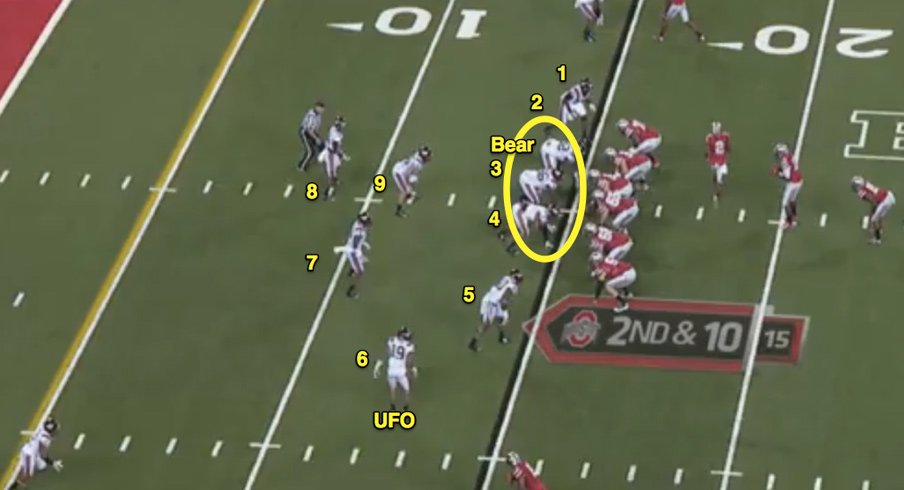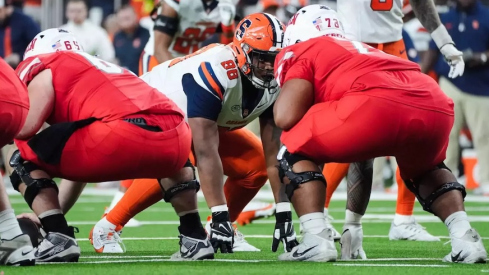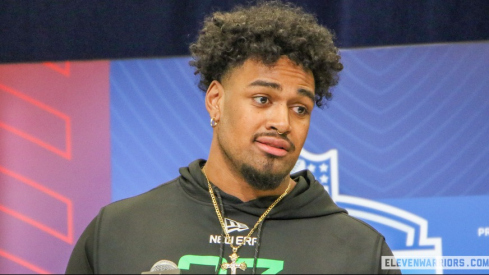For four straight games, Ohio State has faced a bear defensive front -- often paired with cover 0. Ever since Virginia Tech defeated the Buckeyes by deploying this defense, teams have copycatted the Hokies in an attempt to slow down Urban Meyer and Tom Herman's offense. The opponents' goal is simple -- take away the Buckeyes' base inside run game and force Ohio State out of its comfort zone.
Meyer and Herman have quickly adapted, as the Buckeye offense has scored over 50 points each of the last three games. Yet opponents will likely continue deploying the bear, preferring to take away the Buckeyes' tight zone read play -- even if it leaves them vulnerable elsewhere.
The bye week provides an opportunity for an in-depth review of the bear defense, how the Buckeyes have responded, and how Herman and Meyer may continue to adjust going forward.
Taking Away Your Straight Line
The bear, or double eagle defense, is not new. It has existed for many years and was the base alignment for Buddy Ryan's 46 defense.
The bear's primary feature is covering both guards and the center with defensive linemen. A nose guard aligns head up on the center, while two three techniques set-up on the outside half of the offensive guards.
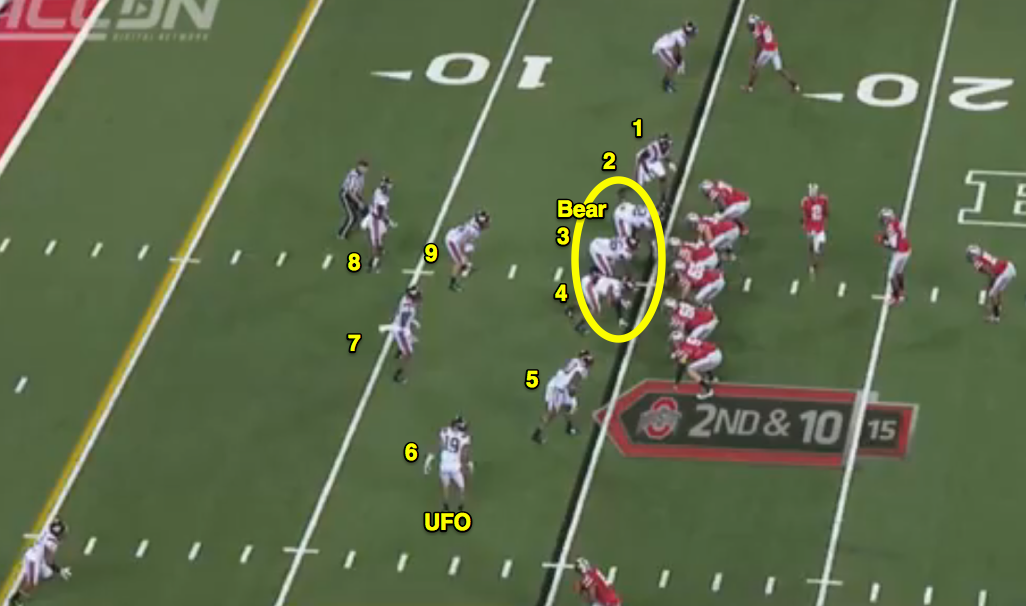
This alignment is particularly appealing to defensive coaches against Ohio State because of how the Buckeyes run the football. Ohio State's base run play is tight zone read. The aiming point for the play is from the frontside leg of the center to the center's backside leg.
Meyer and Herman prefer running the play when the halfback is on the same side as the defense's three technique. This creates a natural cut-back bubble for the play. The front-side center and guard combo the one-technique, and the backside guard and tackle combo the three technique onto the inside linebackers.
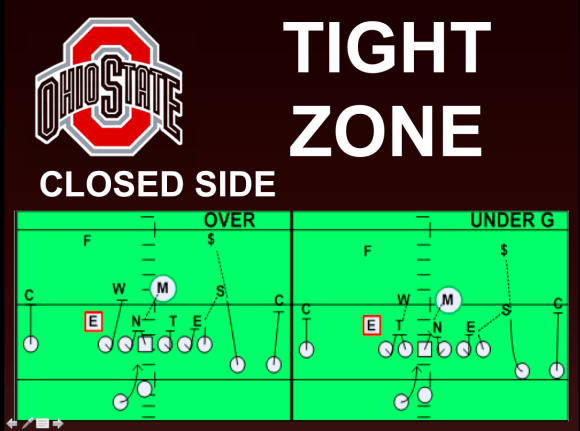
Here's footage:
Mind the Gap
The bear eliminates any inside bubble on tight zone. Interior double teams are likewise eliminated, requiring single blocks, rendering the play far less effective.
The gaps in the bear are instead in the c gaps, on the tackles' outside legs. But the Buckeyes are not an off-tackle run team. Even the Buckeyes' power play is a quick hitting, vertical play. And it is difficult to pull a guard against the bear, as it requires the center to block back against a three technique while being covered by a nose.
As such, Herman and Meyer largely abandoned their inside run game against Virginia Tech's bear front. The Buckeye coaching staff turned towards their first response to being out-numbered at the point of attack -- speed option and the quarterback run game.
But JT Barrett is not the same dynamic run threat as Braxton Miller. Bud Foster preferred to have Barrett running the football then the Buckeye tailbacks and slot receivers. Without a run threat the offense had to rely on an inconsistent passing game.
Bear Beaters
Following the loss, Meyer and Herman's first order of business was ensuring a team could not take away the Buckeye run game by alignment. Enter bear beaters -- automatic checks to run plays that take advantage of the bear's set-up.
Both Ohio State bear beaters utilize a pulling tackle, since he is uncovered. The first is a counter trap towards the halfback side. The guard rides out the 3-technique and the tackle traps the inside linebacker. The outside linebacker is held by the backfield action, creating a natural gap.
The second is a tackle power play, also known as wrap. The tackle -- rather than the guard -- pulls and leads through the opposite C gap. This allows the rest of the line to base block the down defensive linemen.
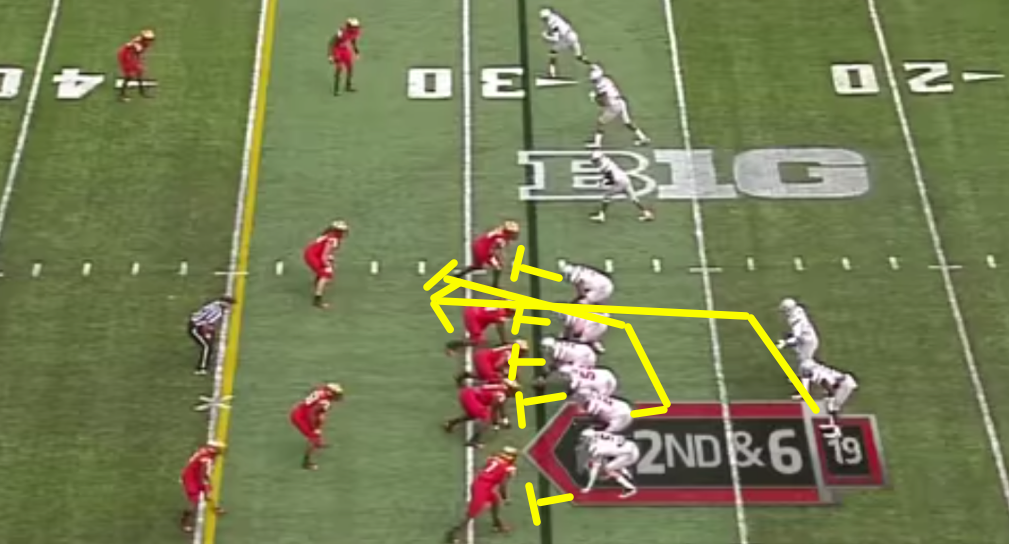
Meyer and Herman have also added wrinkles to their base tight zone and power plays. For instance, in short yardage the Buckeyes will line up in tackle over and run inside zone from the pistol, blocking down on the interior line. Again, the goal is to take advantage of the bear's alignment and enable the Buckeye inside run game.
Mano a Mano
Such adjustments can only go so far, however, when a team does not play a deep safety and goes cover 0. This allows the defense to put nine men in the box.
As noted, Meyer and Herman's first response to run the football is speed option. By optioning a defender the offense can re-equate numbers. And after struggling with running the play early, JT Barrett has learned to attack the option man and get the ball out of his hands.
The Buckeye offense has also adapted with increased man beaters -- routes designed to beat man coverage. Against Virginia Tech, the focus was on hitting vertical routes. But the Buckeyes were inconsistent in doing so.
In recent weeks Herman and Meyer have done a better job mixing and matching 3 verticals with shorter hitting man beaters. One such staple is double slants. It is a quick hitting play with the benefit of matching up a slot receiver against a linebacker or nickel defender. It also creates easy throws against defenders who are playing soft man coverage out of concern of getting beat deep.
Yin and Yang
In the bigger picture, Herman and Meyer face a delicate balance against the bear, cover 0 packages. The Buckeye offense is based around the inside run game. It is essential for Ohio State to run the football inside. Otherwise the offense loses its identity and the Buckeyes cannot set up horizontal plays to the H and passing game.
But at the same time the Buckeyes cannot bang their head against a wall. They must continue to take advantage of teams overplaying the run.
Ohio State should expect bear fronts with cover 0 to remain a staple for opposing defenses this season. This is particularly true in the red zone, where Maryland had some success stopping the Buckeyes simply by amassing more bodies then Ohio State could block.
JT Barrett's touchdown throws to Jalin Marshall and Nick Vannett against the Terrapins provide a blueprint for how the Buckeyes may respond. Expect the Buckeyes to continue using a combination of altered blocking schemes and man beater passing routes so that opponents cannot take Ohio State out of its offense.
